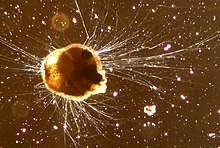
Back Foraminifera Afrikaans مثقبات Arabic منخربات ARZ Foraminiferlər Azerbaijani Фарамініферы Byelorussian Фораминифери Bulgarian Foraminifera BS Foraminífers Catalan Dírkonošci Czech Foraminiferen German
| Foraminifera Temporal range: Latest Ediacaran–Recent
| |
|---|---|

| |
| Live Ammonia tepida (Rotaliida) | |
| Scientific classification | |
| Domain: | Eukaryota |
| Clade: | Diaphoretickes |
| Clade: | SAR |
| Phylum: | Retaria |
| Subphylum: | Foraminifera d'Orbigny, 1826 |
| Subdivisions | |
|
incertae sedis | |
Foraminifera (/fəˌræməˈnɪfərə/ fə-RAM-ə-NIH-fə-rə; Latin for "hole bearers"; informally called "forams") are single-celled organisms, members of a phylum or class of Rhizarian protists characterized by streaming granular ectoplasm for catching food and other uses; and commonly an external shell (called a "test") of diverse forms and materials. Tests of chitin (found in some simple genera, and Textularia in particular) are believed to be the most primitive type. Most foraminifera are marine, the majority of which live on or within the seafloor sediment (i.e., are benthic, with different sized species playing a role within the macrobenthos, meiobenthos, and microbenthos),[2] while a smaller number float in the water column at various depths (i.e., are planktonic), which belong to the suborder Globigerinina.[3] Fewer are known from freshwater[4] or brackish[5] conditions, and some very few (nonaquatic) soil species have been identified through molecular analysis of small subunit ribosomal DNA.[6][7]
Foraminifera typically produce a test, or shell, which can have either one or multiple chambers, some becoming quite elaborate in structure.[8] These shells are commonly made of calcium carbonate (CaCO
3) or agglutinated sediment particles. Over 50,000 species are recognized, both living (6,700–10,000)[9][10] and fossil (40,000).[11][12] They are usually less than 1 mm in size, but some are much larger, the largest species reaching up to 20 cm.[13]
In modern scientific English, the term foraminifera is both singular and plural (irrespective of the word's Latin derivation), and is used to describe one or more specimens or taxa: its usage as singular or plural must be determined from context. Foraminifera is frequently used informally to describe the group, and in these cases is generally lowercase.[14]
- ^ Laura Wegener Parfrey; Daniel J G Lahr; Andrew H Knoll; Laura A Katz (16 August 2011). "Estimating the timing of early eukaryotic diversification with multigene molecular clocks" (PDF). Proceedings of the National Academy of Sciences of the United States of America. 108 (33): 13624–9. Bibcode:2011PNAS..10813624P. doi:10.1073/PNAS.1110633108. ISSN 0027-8424. PMC 3158185. PMID 21810989. Wikidata Q24614721.
- ^ Binczewska, Anna; Polovodova Asteman, Irina; Farmer, Elizabeth J. (2014), "Foraminifers (Benthic)", in Harff, Jan; Meschede, Martin; Petersen, Sven; Thiede, Jörn (eds.), Encyclopedia of Marine Geosciences, Dordrecht: Springer Netherlands, pp. 1–8, doi:10.1007/978-94-007-6644-0_60-1, ISBN 978-94-007-6644-0, retrieved 13 May 2021
- ^ Kimoto, Katsunori (2015), Ohtsuka, Susumu; Suzaki, Toshinobu; Horiguchi, Takeo; Suzuki, Noritoshi (eds.), "Planktic Foraminifera", Marine Protists: Diversity and Dynamics, Tokyo: Springer Japan, pp. 129–178, doi:10.1007/978-4-431-55130-0_7, ISBN 978-4-431-55130-0, retrieved 13 May 2021
- ^ Siemensma, Ferry; Apothéloz-Perret-Gentil, Laure; Holzmann, Maria; Clauss, Steffen; Völcker, Eckhard; Pawlowski, Jan (1 August 2017). "Taxonomic revision of freshwater foraminifera with the description of two new agglutinated species and genera". European Journal of Protistology. 60: 28–44. doi:10.1016/j.ejop.2017.05.006. ISSN 0932-4739. PMID 28609684.
- ^ Boltovskoy, Esteban; Wright, Ramil (1976), Boltovskoy, Esteban; Wright, Ramil (eds.), "Benthonic Foraminifera of Brackish, Hypersaline, Ultrasaline, and Fresh Waters", Recent Foraminifera, Dordrecht: Springer Netherlands, pp. 139–150, doi:10.1007/978-94-017-2860-7_5, ISBN 978-94-017-2860-7, retrieved 13 May 2021
- ^ Giere, Olav (2009). Meiobenthology: the microscopic motile fauna of aquatic sediments (2nd ed.). Berlin: Springer. ISBN 978-3540686576.
- ^ Lejzerowicz, Franck; Pawlowski, Jan; Fraissinet-Tachet, Laurence; Marmeisse, Roland (1 September 2010). "Molecular evidence for widespread occurrence of Foraminifera in soils". Environmental Microbiology. 12 (9): 2518–26. doi:10.1111/j.1462-2920.2010.02225.x. PMID 20406290. S2CID 20940138.
- ^ Kennett, J.P.; Srinivasan, M.S. (1983). Neogene planktonic foraminifera: a phylogenetic atlas. Hutchinson Ross. ISBN 978-0-87933-070-5.
- ^ Pawlowski, J.; Lejzerowicz, F.; Esling, P. (1 October 2014). "Next-Generation Environmental Diversity Surveys of Foraminifera: Preparing the Future". The Biological Bulletin. 227 (2): 93–106. doi:10.1086/BBLv227n2p93. ISSN 0006-3185. PMID 25411369. S2CID 24388876.
- ^ Ald, S.M. et al. (2007) Diversity, Nomenclature, and Taxonomy of Protists, Syst. Biol. 56(4), 684–689, DOI: 10.1080/10635150701494127.
- ^ Pawlowski, J., Lejzerowicz, F., & Esling, P. (2014). Next-generation environmental diversity surveys of foraminifera: preparing the future. The Biological Bulletin, 227(2), 93-106.
- ^ "World Foraminifera Database".
- ^ Marshall M (3 February 2010). "Zoologger: 'Living beach ball' is giant single cell". New Scientist.
- ^ Lipps JH, Finger KL, Walker SE (October 2011). "What Should We call the Foraminifera" (PDF). Journal of Foraminiferal Research. 41 (4): 309–313. doi:10.2113/gsjfr.41.4.309. Retrieved 10 April 2018.
© MMXXIII Rich X Search. We shall prevail. All rights reserved. Rich X Search